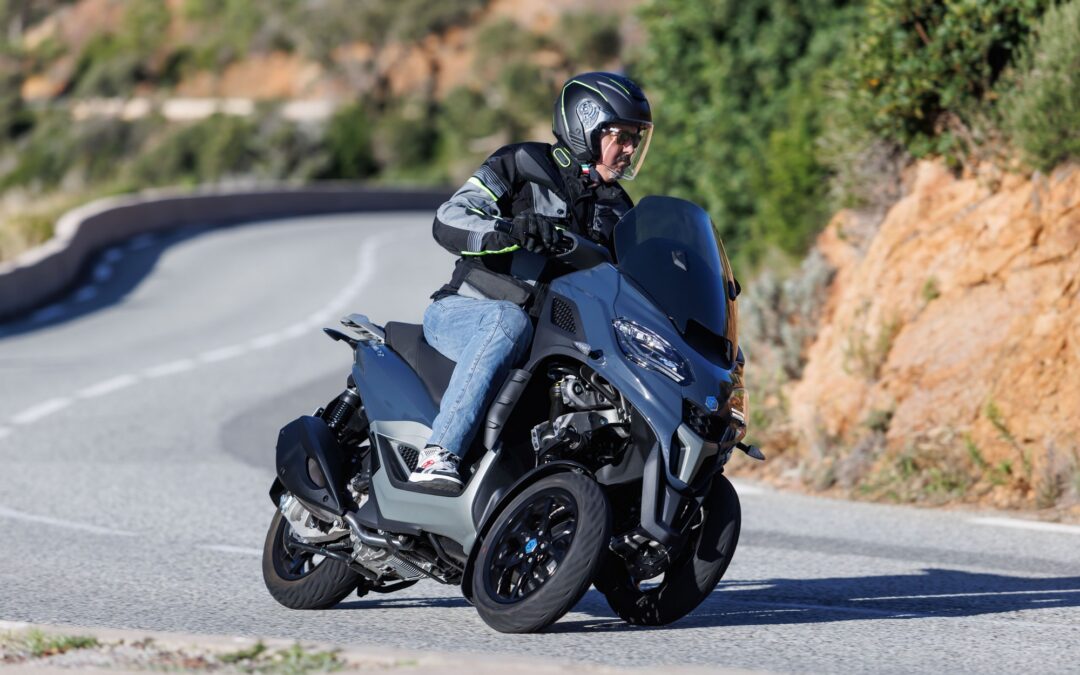Scooter and motorcycle safety tech is evolving quickly, and Piaggio Fast Forward (PFF) has joined the fray with what they call the industry’s first 4D radar-based collision prevention platform. Piaggio Fast Forward is a subsidiary of Piaggio – the parent company of the Vespa and Piaggio scooter brands along with Aprilia and Moto Guzzi motorcycles
The team at technology-focussed Piaggio Fast Forward aims to reduce rider risks with their new Rider Assistance Solution (RAS).
The system uses high-resolution radar to detect hazards multiple times per second, running algorithms to assess risk and issue alerts.
First introduced on the Piaggio MP3 scooter (pictured) with a rear-only sensor, RAS made its full debut on the Moto Guzzi Stelvio motorcycle, where it now offers blind spot monitoring, lane change assist, forward-collision warnings, and following cruise control.
By late 2026, PFF has revealed that features such as stationary rear collision prediction and reversing sensors may also be added.
RAS combines front- and rear-mounted sensors to monitor surrounding traffic in real time, providing specific warnings through the bike’s dash and mirrors.
“The front sensor predicts collisions with vehicles in your trajectory, while the rear sensor predicts collisions when you change lanes or if a vehicle is in your blind spot or an adjacent lane.
PFF’s technology is purely designed to warn the rider – not take control of the motorcycle. Hazards are indicated through dashboard alerts, such as a red triangle for forward-collision warnings.
However, PFF is actively exploring intervention technologies, such as emergency braking.
Piaggio’s system uses high-resolution 4D radar-on-chip sensors, meaning it monitors the height, distance, and movement of objects in the surrounding environment.
The software plots a very specific corridor that the bike travels through. If vehicles move along the periphery of this, it doesn’t take action.
At this stage the system doesn’t identify whether a target is static or moving. Using an algorithm, it can however, predict collisions and monitor danger in real time.
Unlike camera-based systems, RAS employs radar to function effectively in all weather and lighting conditions.
PFF chose radar because it’s immune to weather, whereas a camera system would be affected by rain, fog, dust or darkness.
PFF claims its system provides the highest resolution of any competitor. The higher the resolution, the more precise the understanding of where hazards are.
Currently, the front-facing sensor can detect objects up to 150m away, while the rear module covers 30m – reportedly plenty even for motorway speeds.
As it evolves, PFF aims to extend the frontal range to 300m.
“The motorcycle and in particular the scooter industry is very cost-sensitive, so, the first thing PFF are working on is finding ways to make the module less costly. The second is to see further.
I’d imagine the first Piaggio based scooters to get this tech will be premium scooters like the Piaggio Beverly 400 and maybe the Vespa GTS and GTV range. There is no announcement at the time of writing as to when we can expect it on scooters, but as it has been fitted to one of the groups motorcycles, scooters won’t be far behind. We’ll keep readers up to date with the latest in the Scooter Central Newsletters, so make sure you’ve signed up.

